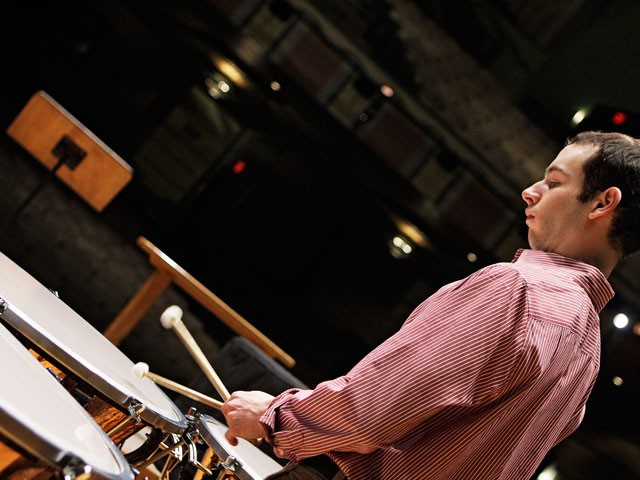He was warming up, alone, onstage at the Fox, and you could hear him out in the lobby. That’s how loud the timpani are.
A short while later, in a solo showpiece, Adam Wallstein was demonstrating thunderous, staccato speed on four drums. Whether or not you know anything about percussion technique, watching the Spokane Symphony Orchestra’s principal timpanist play is the kind of mesmerizing, feel-it-in-your-gut experience that turns you into a 4-year-old: Listen to Wallstein play, and all you want to do is pound on wooden blocks.
You’ll have a chance to feel the timpani’s visceral impact during Thursday night’s SSO performance of Beethoven’s Ninth Symphony. Eckart Preu has copied a German tradition by programming the Ninth for New Year’s Eve — and among showcases for timpani, the Ninth is right at the top.
When Wallstein plays, the musical impulses travel from his brain and quicksilver hands through wooden mallets tipped with felt or chamois; the mallets bang onto PET plastic (the same as in one-liter pop bottles) stretched taut across each of four copper “bowls” (hand-hammered, an eighth of an inch thick, varying in shape from half grapefruit to half football). And then the sound reverberates out onto Sprague Avenue.
In performance, timpanists are “exposed,” as orchestral musicians say — even visually. They’re standing up there all alone, and their entrances tend to be sonic booms — sudden, brief, loud, dramatic.
Playing the timpani is more complicated than you might think. Wallstein controls the each drum’s pitch with a foot pedal, and in Beethoven’s Ninth, he’ll be busy between movements: “I’ll have to initially tune [the two center drums] to D and A,” he says, “then change to octave F’s for the second movement, followed by F and B-fl at, and finally back to D and A for the finale.”
He owns about 40 pairs of mallets. He covers the tips with felt for a softer, fuller sound, or with hard chamois for a sharper attack. The coverings deteriorate quickly — you would too, if somebody was beating on you all the time — and so Wallstein often spends about half an hour on weekends cutting out sheets of felt, them trimming them to size and “sewing them on with dental fl oss.”
A little kid dreams of being a soldier or a firefighter, not a principal timpanist. So how did Wallstein get his job training? Back in southern Vermont, one of his eight-hgrade friends was really into drumming. That led to young Adam practicing on his bedroom floor, pounding on circles of carpet. His father earned a living as a pianist and vocal coach, so serious music was always in the home. Wallstein studied on snare drum, moved on to other percussion instruments (tambourine, cymbals, triangle), then discovered a) that he loved classical music, and b) that playing timpani was a solid route toward playing in an orchestra. On a percussion instrument with lots of rests, moreover, he could also spend a lot of downtime during performances luxuriating in the sounds of Brahms, Mahler and Sibelius.
He won the Spokane audition in January 2002 — months before graduating from Boston University — and he’s been principal timpanist here ever since.
When a symphony is being performed, Wallstein listens more than he plays. (Timpani tend to be employed in sporadic flurries of notes.) Fortunately, he’s a real student of the music. He makes a point of studying entire orchestral scores — even for works that feature long, long rests for the timpanist. (Before his fi rst entrance in the complete Handel Messiah, for example, the timpanist sits around for an hour and a half.)And what does Wallstein think about during those long rests? “Well, we had better report to Eckart and Symphony management that my thoughts are always entirely focused on the music at hand, in earnest preparation for my next entrance,” he writes in an e-mail.
He’s having his little joke, but he’s serious too: He studies entire scores to glean clues about the composer’s intentions. He’s meticulous about knowing what “gestures” the score makes, even in passages far removed from the timpani’s part, so that he can be responsive to them when it does come to his turn to play.
“Some musicians are really into their instruments,” he says, “but I’m in it for the music, and not so much for my own contribution.” And he’s worried about the music’s reputation.
Many people, Wallstein says, “regard classical music as stuffy, hopelessly intellectual and buttoned-up.” So orchestras compensate by trying “to market themselves as fun and hip — ‘all the young people are doing it!’ But I think it’s not either of those extremes.”
Art music, far from being all brainiac, can be passionate — even, as Wallstein says, “a source of spiritual exaltation.” But on the other hand, it’s not immediately accessible, either. “You have to concentrate on it for a half hour, an hour,” he says. “You will never fall in love with it unless you make an investment” — repeated listenings, attending concerts — “and that goes against the grain of our culture today.”
For the hour of music known as Beethoven’s Ninth, you might want to concentrate on the guy in the monkey suit standing up stage left and surrounded by four copper drums. He’ll adjust his pedals, bend low to monitor the pitch, splay his fi ngers to dampen vibration — and erupt into a pounding, cascading blur.
Then he’ll sit back quietly and listen to the music he loves. You should join him.
The Spokane Symphony Orchestra performs Beethoven’s Ninth Symphony at the Fox on Thursday, Dec. 31, at 7:30 pm. Tickets: $20- $25. Visit spokanesymphony.org or call 624-1200 or 325-SEAT.
















